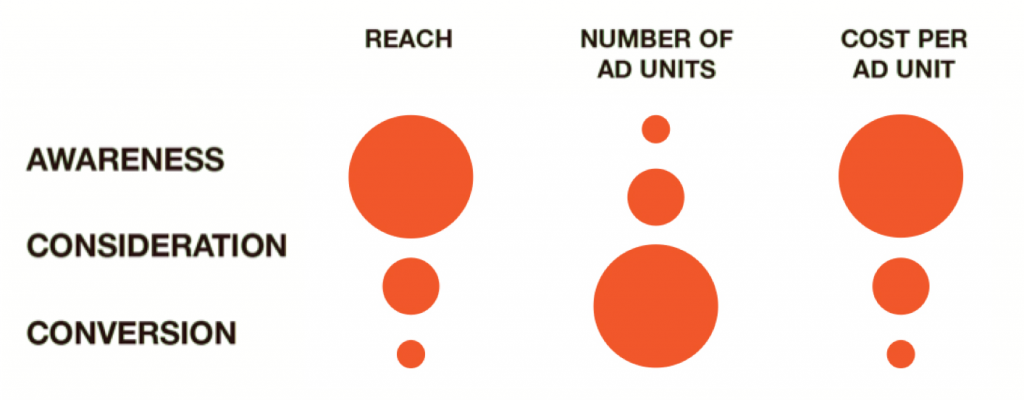
A lot of discussion in recent years has been around too much allocation of comms spend going towards tactical and digital activities. While some point to the lobbying muscle of Facebook and Google, and some say the blame is on an industry too focused on being trendy, there is one thing few focus on: the lack of hierarchy in marketing today.
Generally, most people in digital advertising are not evil or sinister. They are just trying to maximize the value of clients budgets in relation to some given KPI:s. In the tactical space, they are doing their best efforts. And if their client contact offers them a higher budget, well hey, someone on the client side has probably done some diagnosis and strategy work to support that allocation of budget.
The same goes for the people at the media agency, the creative lead agency, the performance agency and the agency working with retail. They all maximize the value of their field, and the overall strategy is not their responsibility.
But what if there has been no overall strategy at all?
If there is no conductor, each member of the orchestra will just start playing louder and louder. Even the best violinist in the world has difficulty finding his or her role in an orchestra without sheet music or a conductors’ guidance.
And even if it was possible for that violinist to learn in detail the relative roles of every instrument in the libretto, that would just be inefficient: The main idea of having a conductor is to not have to make all 90 musicians learn the overall picture in detail, but allow them to become specialists. And at the same time to allow the conductor to focus solely on conducting, being able to control every section of the orchestra and to make them work together to create beautiful music.
As different disciplines within marketing are playing their individual tunes, we risk missing out on synergies. Also, if there is no conductor with an overview of all elements, people risk trying to impose learnings and models relevant to one discipline to others, even though they do not apply there. While the insights from Binet & Field regarding a trend of over-investment in digital is true within comms, it may not apply to product development or distribution. While new digital KPI:s and A/B testing can be relevant for tactical comms, it may be all wrong when it comes to branding.
What might then be the ground for a development with more siloed disciplines within marketing? To my mind three interconnected trends drive this development:
- A lack of mandate for overall orchestration of the things that drive growth
- An increased focus on short term profits
- The fear of missing out on new trends and technologies
Marketing is traditionally a discipline encompassing all activities that generate money to a company. As outlined by Mark Ritson et al there is a great importance in diagnosing your market, setting a strategy, and then executing that strategy across both Product development, Pricing, Promotion (comms) and Place (distribution). With a helicopter view across all these elements, you can see how they interact, make informed trade-offs between different initiatives, and work long term.

However, recently CMO:s have lost a lot of control in this area. When Dentsu surveyed 1000 CMOs across the globe, many of the top responses indicate decreasing control: Lack of integration, insufficient control and competing agendas with the rest of the C-suite are all key challenges for implementing the marketing strategy.

As summarized in the very pertinently titled article Why CMOs are only lasting as long as Spinal Tap drummers: “First, finance officers took away pricing. Then, strategy officers who took away market analysis and strategic planning. Product officers took away product. Operations and logistics officers took away distribution. Sales officers took away sales.”
So the mandate of the marketing function is diminishing. At the same time, the same function is still responsible for growth, a paradox that some say may be the cause of CMO:s being the most short lived members of the C-suite. This leads to the second underlying cause of the marketing cacophony: Short termism.
There are a lot of reasons that we are getting more short term focused. Stock markets looking at every quarters sales figures is one driver. Another is the influx of more and more short-term data claiming our attention. On a larger scale, some say that we are in a midst of a global trend across not only marketing but society at large where we are more tactical, and data focused.
The short term focus leads to wanting to maximize the value in each channel or discipline straight away, without taking time to see how such a push affects the bigger picture. “Can we save money in distribution by going digital – let’s do it! How does the loss of physical outlets affect our service level and premium brand position? Dunno, that’s not my responsibility and I don´t have time to check.”
Digitalization, in turn, leads us to the third Horseman of the marketing Apocalypse; FOMO.
From Apps to social media to the current day holy grails of AI, AR and Agile, there seems to be and increasing trend in wanting to be part of the latest marketing trends. And as digitalization adds new needs, new expertise is needed, the traditional lead agencies lose their grip of the overall picture. Social Media agencies, performance agencies, digital agencies take control of different aspects of the puzzle. And perhaps a CMO is too afraid to reveal a lack of understanding to take charge. Better let some new CXO take charge of that new thing.
That is why we end up with a lack of central leadership. And as a consequence of that void, the different instruments in the orchestra start riffing on their own solos. Suddenly the “CSMO” and the social media agency start developing their own diagnosis and strategy, diagnosis and strategy based only on achieving their siloed KPI:s. The Head of Product Development develops his/her own view of the world and strategic prioritizations, perhaps even finding a target group definition that suits the product developments. And then you end up with TikTok Strategies, retargeting marketing that destroys brands, too much consumer centricity in branding, not enough consumer centricity UX, and a general lack of consistency across disciplines and time.
So what might be the remedy? It probably comes down to a clear division of labor: As the complexity of the marketing game increases, each player needs to understand the overall picture, understand what role their instrument plays in it, and at least have some rudimentary understanding of what roles others are playing. Getting a bit humble. If you say; I am fully aware I only play one of many instruments, but this is how I think mine should be best played, is so much more graceful than saying THIS IS THE TRUMPET LET’S PLAY MORE TRUMPET.
- People in digital/social media: Binet & field DOES show we have gotten too tactical
- People in traditional brand building: There ARE interesting new channels and formats within digital that can play a great role in tactical advertising
- Comms people: Outside of Comms, digital DOES have interesting potential within the extended product experience (CX) and distribution
- People in media tactics: Sometimes the value of consistency MUST trump channel adaptation
- People in branding: Sometimes a channel I so relevant it CAN warrant doing some adaptation to fit messaging
- Etc
As for the role of overall vision, the CMO probably needs to take more charge in the boardroom – by leaning on the science behind marketing and getting more savvy in new technologies and buzzwords coming along. Understanding how these things can contribute to growth is key to arguing they should be subordinated to the growth agenda.
There is no shame in doing great tactics. But it should not be confused with strategy. There is no shame in being the greatest violinist in the game. But that skill should not be confused with – nor substitute – the need for orchestration.








